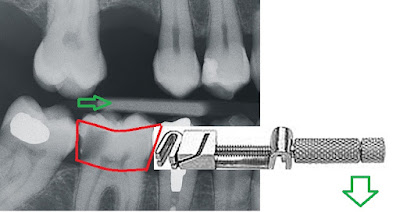Another note on Tofflemires
Working in the public acute care clinics means that a lot of the dentistry that I do when I am there is compromised. The goal is to provide relief of pain and to deal with the patient's main complaint in the simplest, quickest way possible simply due to time constraints. Therefore lately I have found that I am using a tofflemire matrix a lot more than I used to. I've previously written about some tips for using Tofflemire matrices:
http://dental-tidbits.blogspot.com/2020/01/limitations-of-tofflemire-bands.html
http://dental-tidbits.blogspot.com/2021/03/difficult-restorative-appointment.html
http://dental-tidbits.blogspot.com/2020/09/a-note-on-tofflemire-matrix-retainers.html
http://dental-tidbits.blogspot.com/2019/09/review-of-old-blog-post.html
The difficulties I have found with tofflemires is that initially it is very difficult to get a contact with the adjacent tooth and when you can get a contact it is of poor contour and in the wrong location much to close to the adjacent marginal ridge. As the band itself is of flat contour, the wedge even when customised can contact the buccal and lingual embrasure areas of the band and force the band away from the adjacent tooth. I am planing to write a post in the near future on wedge customisation with tips on how to get around this problem.
The limitation I noticed which prompted this post was in relation to the matrix pulling away from the adjacent tooth. The issue is that the tofflemire band requires a retainer to seal the band against the tooth. This retainer can represent a significant level arm and gravity or force from the patient's lip can canuse the band to dislodge from the place you have placed it. Notably, if you are restoring a distal interproximal cavity and the retainer arm moves gingivally, the band at the distal tends to move away from the tooth due to rotation of the retainer at the retainer-band interface. The next time you are using a tofflemire band, grab hold of the retainer when the band has been secured and move it up and down to see what happens to the adaptation of the band against the adjacent tooth. The most effect seems to happen when there is a wide open class II cavity and there is not much buccal and lingual residual tooth structure to hold the tofflemire in place. My solution here is to ensure that the tofflemire isn't pushed tight against the patient's lip or cheek. If need be, take a mouth mirror and retract the cheek and place it over the tofflemire if the positioning was initially awkward. A cotton roll or two can be placed in the sulcus and this can hold the cheek out of the way and may even prop the retainer up slightly. If this still doesn't work, I use my non dominant hand to hold the retainer in the position that I want it and hold it there for the duration of the material set.

Comments
Post a Comment
Please leave a comment and let me know what you think or if there are any topics you would like covered in the future